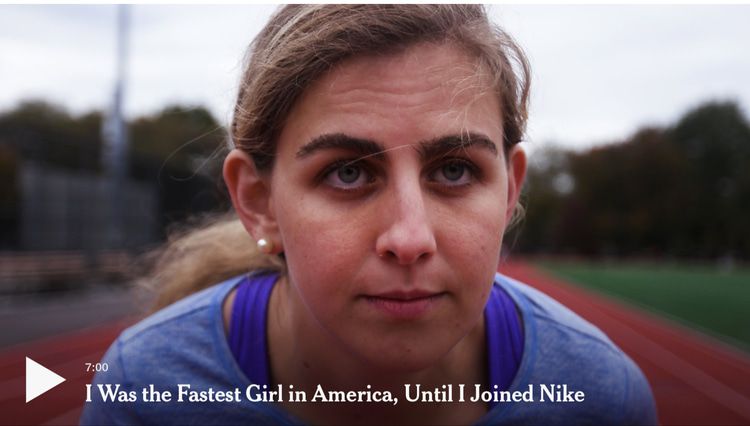From the New York Times:
I Was the Fastest Girl in America, Until I Joined Nike
Mary Cain’s male coaches were convinced she had to get “thinner, and thinner, and thinner.” Then her body started breaking down.
Mary Cain became, in 2013, the youngest American track and field athlete to make a World Championships team.
Nov. 7, 2019
At 17, Mary Cain was already a record-breaking phenom: the fastest girl in a generation, and the youngest American track and field athlete to make a World Championships team. In 2013, she was signed by the best track team in the world, Nike’s Oregon Project, run by its star coach Alberto Salazar.
My impression is that Salazar has been suspected of being a PEDs-pushing coach since Mary Decker, under his tutelage, got into doping trouble in 1996-1999.
Then everything collapsed. Her fall was just as spectacular as her rise, and she shares that story for the first time in the Video Op-Ed above.
Instead of becoming a symbol of girls’ unlimited potential in sports,
Maybe girls don’t have unlimited potential in sports?
Cain became yet another standout young athlete who got beaten down by a win-at-all-costs culture. Girls like Cain become damaged goods and fade away. We rarely hear what happened to them. We move on. …
The problem is so common it affected the only other female athlete featured in the last Nike video ad Cain appeared in, the figure skater Gracie Gold. When the ad came out in 2014, Gold, like Cain, was a prodigy considered talented enough to win a gold medal at the next Olympics. And, like Cain, Gold got caught in a system where she was compelled to become thinner and thinner. Gold developed disordered eating to the point of imagining taking her life.
Nike has come under fire in recent months for doping charges involving Salazar. He is now banned from the sport for four years, and his elite Nike team has been dismantled. In October, Nike’s chief executive resigned. (In an email, Salazar denied many of Cain’s claims, and said he had supported her health and welfare. Nike did not respond to a request for comment.)
The culture that created Salazar remains.
Kara Goucher, an Olympic distance runner who trained with the same program under Salazar until 2011, said she experienced a similar environment, with teammates weighed in front of one another.
“When you’re training in a program like this, you’re constantly reminded how lucky you are to be there, how anyone would want to be there, and it’s this weird feeling of, ‘Well, then, I can’t leave it. Who am I without it?’” Goucher said. “When someone proposes something you don’t want to do, whether it’s weight loss or drugs, you wonder, ‘Is this what it takes? Maybe it is, and I don’t want to have regrets.’ Your careers are so short. You are desperate. You want to capitalize on your career, but you’re not sure at what cost.”
She said that after being cooked meager meals by an assistant coach, she often had to eat more in the privacy of her condo room, nervous he would hear her open the wrappers of the energy bars she had there.
A big part of this problem is that women and girls are being forced to meet athletic standards that are based on how men and boys develop. If you try to make a girl fit a boy’s development timeline, her body is at risk of breaking down. That is what happened to Cain.
After months of dieting and frustration, Cain found herself choosing between training with the best team in the world, or potentially developing osteoporosis or even infertility. She lost her period for three years and broke five bones. She went from being a once-in-a-generation Olympic hopeful to having suicidal thoughts.
It’s almost as if female fertility correlates with having some reserves of fat, of not being stretched to the physical limit.
“America loves a good child prodigy story, and business is ready and waiting to exploit that story, especially when it comes to girls,” said Lauren Fleshman, who ran for Nike until 2012. “When you have these kinds of good girls, girls who are good at following directions to the point of excelling, you’ll find a system that’s happy to take them. And it’s rife with abuse.”
Anorexia tends to be an upper crust mental illness. Mary Cain, for example, grew up in Bronxville in Westchester County, NY. Bronxville is by some measures the most expensive suburb in America.
As I wrote last year:
Anorexia in modern America is a mental illness found mostly in affluent, very competitive females who come from social environments where being fat is a symptom of deplorability. The girls tend to internalize their culture’s and their moms’ prejudice against weight to the point where they are in danger of starving to death.
They look in the mirror at their 85 pound selves and just see FATNESS.
[Comment at Unz.com]













